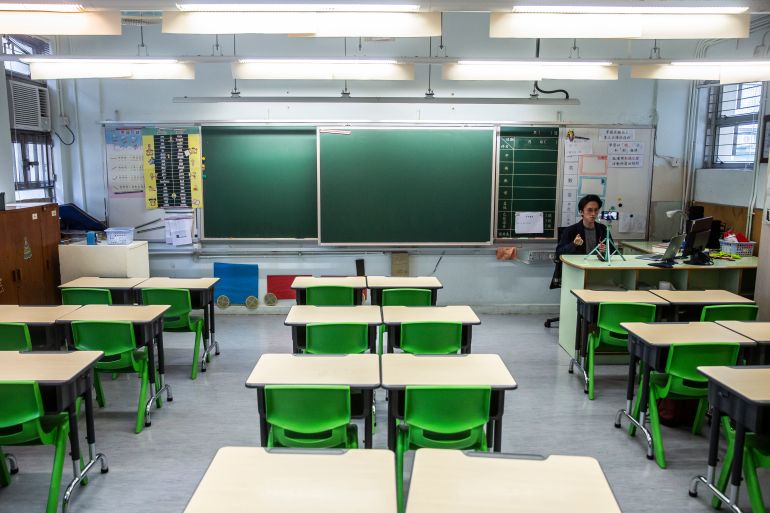It is time to prioritise education for recovery
Longer term efforts to fund education equitably should be at the heart of the recovery from the pandemic.

Another school term has started. For millions of students, it does not mean school doors are opening; but a return to distance learning, yet again. Since the beginning of this pandemic, more than 1.6 billion children and youth have been affected by academic closures. Over half of all students are still facing major disruptions to their learning, ranging from full school closures to reduced or part-time schedules. Prolonged and repeated school closures are increasing learning losses and taking a toll on the mental health of students worldwide.
But it is the most vulnerable children and young people that are bearing the brunt of COVID-19 on their education and future. Remote learning has left nearly 500 million students unable to access education. The combined effect of school closures and the economic recession has been especially devastating for girls, children from poor families and those with disabilities. Only a handful of countries can offer effective online distance learning. In sub-Saharan Africa, four out of five learners do not have access to the internet. UNESCO estimates that 24 million students may never see the inside of a classroom again. Decades of progress risk being reversed, widening inequalities and amplifying the learning crisis.
Keep reading
list of 4 itemsWill the coronavirus change higher education forever?
Kenya, coronavirus and the global education gap
Can the education gap be bridged worldwide?
There is hope on the horizon. The World Bank projects that the global economy will expand by 4 percent in 2021 – a positive outlook that depends on the effective roll-out of vaccines. During this period of recovery, investments that lay the foundation for a more equitable future will be vital. Policies in education that focus on the most disadvantaged children will mitigate the adverse effects of the pandemic by keeping children in school and learning. But without immediate education financing, 825 million children in low- and middle-income countries will not gain the skills they need to successfully enter the job market by 2030.
These investments are urgent. Currently, education is not prioritised in recovery efforts, receiving a mere 0.78 percent of relief packages worldwide. Squeezed budgets see projections of the total aid to global education declining by 12 percent from now until 2022.
In the immediate future, reopening schools and keeping them open must be a priority, taking every measure to protect the health and wellbeing of teachers and students. Teachers are front-line workers and should be prioritised in vaccination campaigns. Policy responses must also include catch-up programmes for students who have fallen behind, re-enrolment campaigns for children who have dropped out and proper health and hygiene facilities to ensure that schools are reopening safely. This type of up-front investment in catch-up and remedial programmes will save money down the line by reducing the costs of repairing COVID-19-related damage by up to 75 percent.
Longer-term efforts to fund education equitably should be at the heart of the recovery from the pandemic. What this means in practical terms, is that governments and private partners must spend their budgets, however big or small, in ways that actively pursue inclusion and equity in education, such as through cash transfers and social protection measures aimed at the most vulnerable learners. New analysis from the Global Education Monitoring Report finds that only one in five countries demonstrate a strong commitment to equity in education. More worryingly, some countries in sub-Saharan Africa – the region with the most out-of-school children – have no financing policies to promote equity at all.
These findings make the upcoming Global Partnership for Education (GPE) replenishment campaign even more critical. Through its “Raise Your Hand” campaign, GPE is calling for at least $5 billion to help transform education systems in up to 90 lower-income countries and territories. Fully funded, the campaign will enable 175 million girls and boys to learn and enrol a further 88 million more children in school. As government budgets are being further squeezed by the economic fallout of COVID-19, this funding will give them the capacity to make reforms, address bottlenecks in their education systems, train teachers, invest in new and innovative curricula and find creative ways to deliver education to the children most at risk of being left behind. Millions of children around the world will see their future determined at the high-level GPE replenishment summit co-hosted by UK Prime Minister Boris Johnson and President of Kenya, Uhuru Kenyatta in mid-2021.
We call on countries to protect their budgets and work with partner countries in their region to adopt best practices to ensure that education finance reaches the most marginalised leaners. We also call on donors to deliver on their overseas development assistance commitments and to pledge funding to support learners left behind through GPE’s “Raise your Hand” campaign.
Education acts as a bulwark against inequalities; a driver of economic and social development and a basis for nurturing responsible, democratic citizenship. It contributes to all the Sustainable Development Goals. It must be a priority in the recovery. Our world needs it now more than ever before.
The views expressed in this article are the authors’ own and do not necessarily reflect Al Jazeera’s editorial stance.